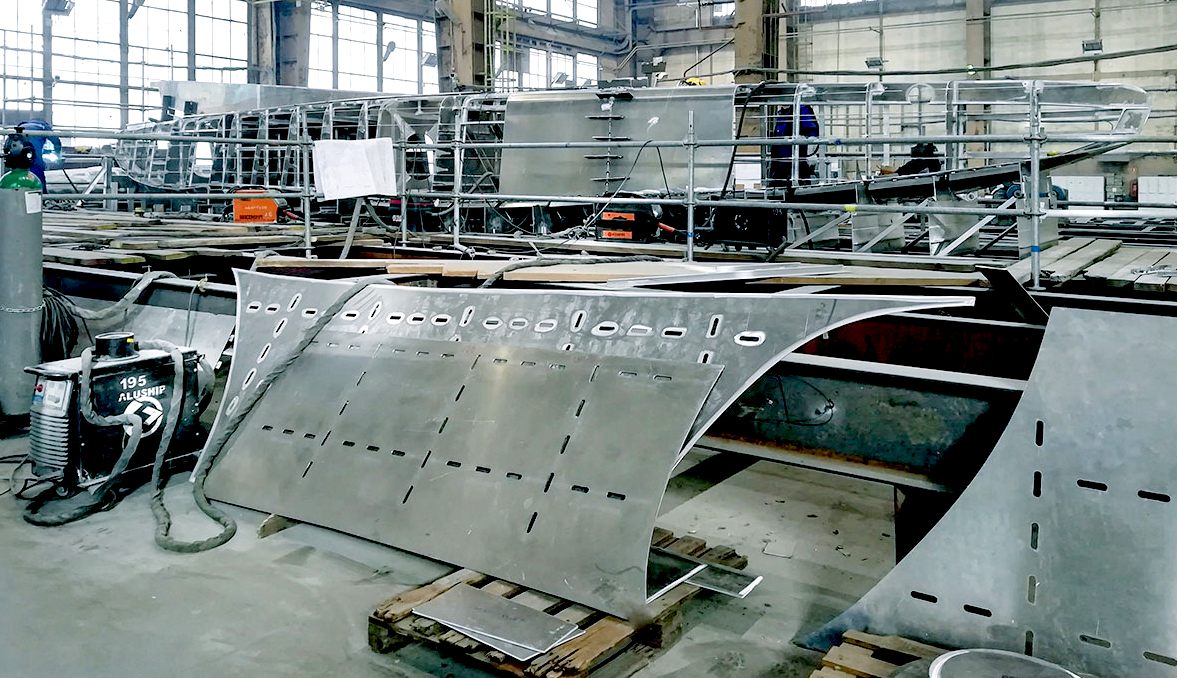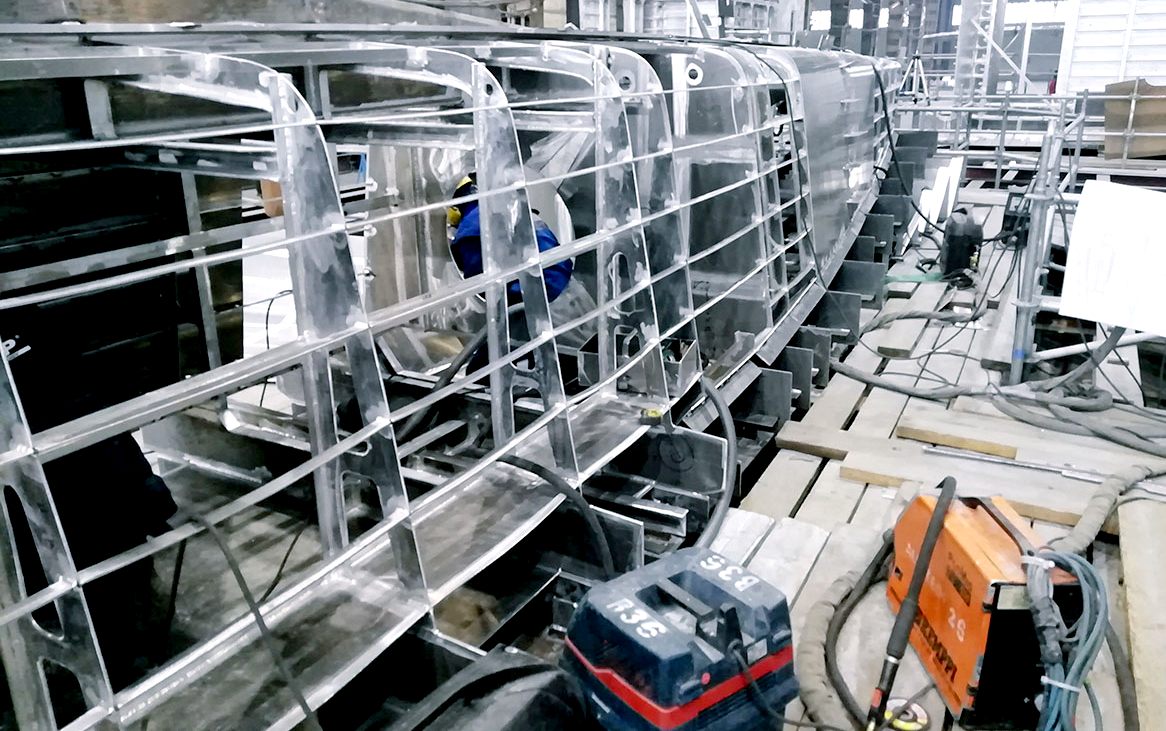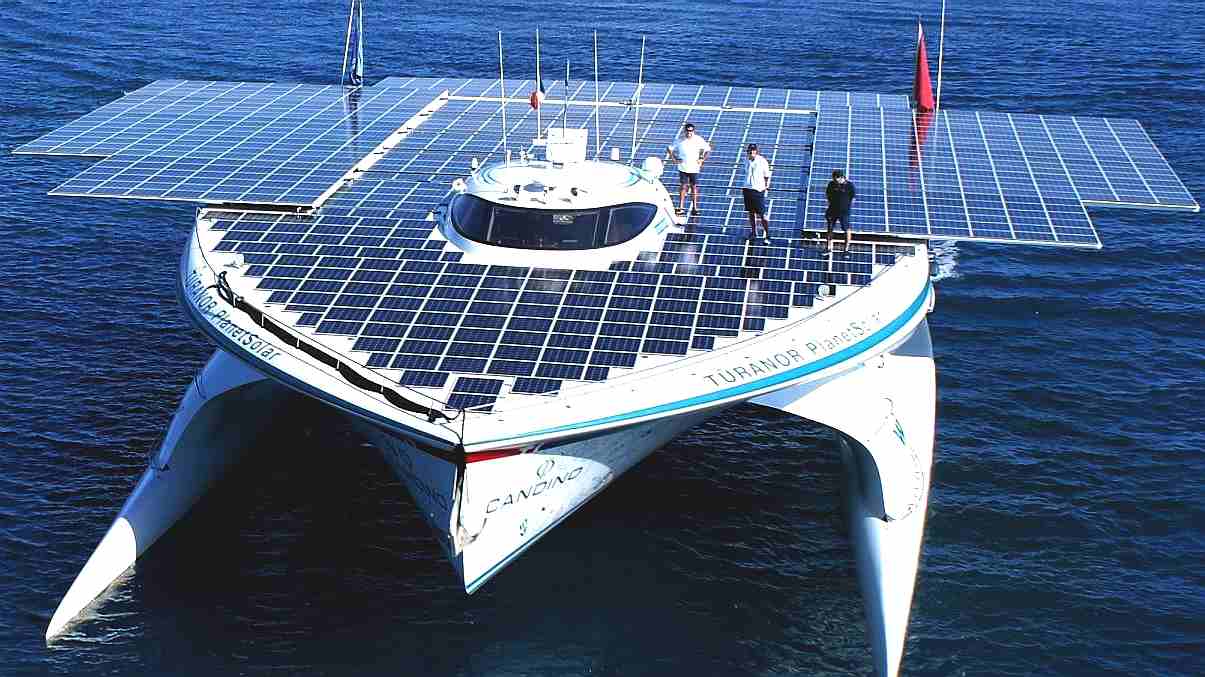
ALUSHIP -
Construction of a large aluminium vessel in 2014
The shipbuilding company 'Aluship Technology' has delivered numerous
aluminium and
steel-aluminium superstructures for passenger vessels.
The scope of their activities include:
- revision and improvement of existing technical Al-design projects
- complete classification process including FEM calculations
- consulting clients for special equipment and devices for aluminium superstructures
- developing specific trapezoid panel with extrusion tool
- class, construction – workshop drawings
-
lofting, nesting, plasma cutting docs
- plasma cutting and marking
- mounting and welding of all sections
- mounting of ready blocks on steel hull at our clients premises
- complete drawings, construction of outfitting parts, windscreens &
other equipment
Aluship own a 4 hectare plot with direct access to the sea in Gdansk harbour. Their facilities consist of 10.000sqm production hall 3.500 sqm of workshops, design office and administration space.
Their Megayacht capacity is between 30 to 171 tons of aluminium and up to 1.200 tons of steel.
Aluship Technology’s engineering office has 42 workstations. They are equipped with AutoCAD, Nupas Cadmatic, Inventor, Rhino, CNC and other software.

CONTACTS
Aluship Technology Sp. z o.o.
ul. Doki 1
80-958 Gdansk
Poland
General email: contact@aluship.com
Inquiries & references: board@aluship.com
Tel: +48 58 506 6868
Fax: +48 58 506 6869
Aluship Technology is a limited company registered in
Regional Court Gdansk-Polnoc in Poland.
KRS (reg no): 0000096454.
REGON: 191956693.
NIP (Vat reg): PL5832644779
RDO: 000161530
Share capital: 2 967 000 PLN

WARSAW THE FIRST NEWS - MARCH 25 2020
Sleek new AI 'Mayflower' to cross Atlantic on 400th anniversary of Pilgrims' voyage.
A Gdańsk shipbuilder is building the hull for a new Mayflower ship which will sail across the Atlantic in recognition of the 400th anniversary of the Pilgrim’s epic 5,150-km voyage to America.
Although bearing the same name as the English ship which set sail for the New World in 1620, the modern version will have neither captain, crew nor passengers.
Instead, the Mayflower Autonomous Ship will use an ‘AI Captain’ designed by IBM to self-navigate across the ocean.

ALUSHIP -
Goetz Linzenmeier, Founder and Chairman
Goetz Linzenmeier, Founder and Chairman of Aluship said: "One common thing on both projects was really a sense of adventure. The original Mayflower had people believing in a special future and putting their lives at risk.
“In this new Mayflower this is also a technological adventure with a highly-sophisticated
trimaran (yacht with 3 hulls) with an even more sophisticated interior, fortunately no life is at risk.”
Gdańsk shipyard’s Aluship was chosen as the hull manufacturer at the end of last year and joined IBM, the University of Plymouth and project leaders ProMare, an American NGO established in 2001 with the aim of promoting marine research and exploration throughout the world.
Aluship technology is renowned for their aluminium frames and have previously contributed sections to megayachts, superstructures to cruise ships and offshore constructions.

The Mayflower Autonomous Ship (MAS) will set sail on 6th September 2020 from Plymouth, England to commemorate the anniversary of the original voyage.
The ship has become a cultural icon in the history of the United States after the Pilgrims who set sail from Plymouth in England founded the
Plymouth Colony in what became New England.
While the original journey took just over 60 days the new fully autonomous Mayflower will make the crossing in an estimated 12 days.
It will be the first full sized autonomous ship to cross the Atlantic and, powered by a hybrid propulsion system, utilizing wind and solar power with a back-up diesel generator, will be able to travel at up to 10 knots per hour.
The modern ship is half the size the original at 15 metres in length and at five tons it weighs just a fraction of the original ships 180 tons.
The next three to four months will involve the MAS being fitted out with the most advanced technology available.
The vessel will not only be equipped with the ‘AI Captain’ from IBM but will also benefit from state-of-the-art inertial navigation and precision
GNSS (Global Navigation Satellite System) positioning system, oceanographic and meteorological instruments, SATCOM, RADAR and also LIDAR technology.
Don Scott, CTO of the Mayflower Autonomous Ship, is quoted as saying: "While the autonomous shipping market is set to grow from
$90 billion today to over $130
billion by 2030, many of today's autonomous ships are really just automated
robots which do not dynamically adapt to new situations and rely heavily on operator override."
“Using an integrated set of IBM's AI, cloud, and edge technologies, we are aiming to give the Mayflower the ability to operate independently in some of the most challenging circumstances on the planet."
The team are hoping to begin sea testing the completed unit in July and August, giving them time to make any adjustments before the anniversary in September.
The journey from Plymouth, England to Plymouth, Massachusetts on the American East coast will likely take the ship close to the
wreckage of the
Titanic but in 2020 it is unlikely to meet any icebergs.
By Nick Westerby
PORTAL MORSKI POLAND MARCH 25 2020
Kadłub współczesnego, autonomicznego Mayflower wyruszył z Gdańska do Wielkiej Brytanii
Cztery wieki po tym, jak żaglowy, drewniany statek pionierów Mayflower przepłynął Atlantyk z Wielkiej Brytanii do Nowego Świata i dotarł do brzegów przyszłych Stanów Zjednoczonych, grupa inżynierów planuje pokonanie Atlantyku tą samą trasą, bezzałogowym (autonomicznym), supernowoczesnym statkiem (ściślej mówiąc jachtem motorowym) również o nazwie Mayflower.
Rejs ma się rozpocząć we wrześniu, a nowy Mayflower może stać się pierwszym "pełnowymiarowym", w pełni autonomicznym statkiem, który przepłynie Atlantyk - twierdzą organizatorzy: IBM i morska grupa badawcza ProMare.
Do września jednostka ma być ostatecznie doposażona i przygotowana do rejsu w brytyjskim Plymouth.
Częściowo, w znacznym stopniu wyposażony, aluminiowy kadłub powstał w gdańskiej stoczni Aluship Technology Sp. z o.o.
Po przekazaniu przez polską stocznię, wyekspediowano go właśnie do Wielkiej Brytanii. We wtorek, 24 marca, kadłub, jako ładunek wielkogabarytowy na platformie drogowej, wyruszył do Plymouth, gdzie zostaną wykonane ostatnie prace.
"Wspólną cechą obu projektów było, tak naprawdę, poczucie przygody. Oryginalny Mayflower miał ludzi wierzących w nadzwyczajną przyszłość i narażających swoje życie - powiedział agencji Reuters Goetz Linzenmeier, prezes i założyciel Aluship Technology Sp. z o.o., która zbudowała kadłub. "W nowym Mayflower jest to również przygoda - technologiczna, ale na szczęście nie jest zagrożone żadne życie."

MAS (Mayflower Autonomous Ship) budowany jest na zlecenie organizacji non-profit zajmującej się badaniami morskimi ProMare we współpracy z zapewniającą systemy autonomiczne firmą IBM.
Statek ma prowadzić "wirtualny kapitan" oparty na sztucznej inteligencji ("AI Captain").
Na podstawie danych z lidarów, radarów, GPS, satelitów i kamer autonomiczny statek samodzielnie będzie podejmować decyzje o zmianie kursu, czy manewrach w celu uniknięcia kolizji. Statek sam może też skorzystać z połączenia za pomocą telefonu satelitarnego, jeśli uzna, że potrzebuje zewnętrznej pomocy. W zatoce Plymouth Sound zbierane są dane z setek innych statków, które pomogą w uczeniu algorytmu MAS (Mayflower Autonomous Ship).
Jednostka jest 15 metrowym trimaranem - składającym się z trzech sztywnych kadłubów, jednego głównego i dwóch stabilizujących - o wadze pięciu ton i prędkości maksymalnej do 20 węzłów. Napędzana będzie energią elektryczną generowaną z wiatru i słońca, choć na pokładzie znajdzie się także awaryjny zespół prądotwórczy oparty na silniku spalinowym.

Według IBM, jednym z wyzwań projektu MAS jest niepewne połączenie ze światem - statek nie może komunikować się z chmurą obliczeniową w trybie ciągłym, gdyż w podróży zdarzać się będą długie przerwy w dostępie do sieci. Kluczowe w podejmowaniu decyzji będzie więc opracowane przez koncern narzędzie ODM, które używane jest m.in. do tworzenia miliardów zaawansowanych funkcji matematycznych na potrzeby rynku finansowego.
W głównym kadłubie znajdą się też trzy moduły badawcze, opracowywane przez naukowców z Uniwersytetu w Plymouth. Mają oni nadzieję, że będzie to pierwsza okazja do zebrania przez autonomiczny statek danych nt. zanieczyszczenia oceanu plastikiem, zwłaszcza jego mikrodrobin. Obecne prognozy zanieczyszczonych obszarów budowane są jedynie na szczątkowych danych i modelach przewidywań. Naukowcy z Plymouth sądzą, że autonomiczne jednostki podobne do MAS podejmujące decyzje na podstawie bieżących danych mogą w przyszłości znacznie ułatwić śledzenie tego zanieczyszczenia.
Oryginalny Mayflower był drewnianym handlowym, lekko uzbrojonym żaglowcem. Nowy Mayflower jest natomiast bardzo wyrafinowanym technicznie trimaranem z jeszcze bardziej wyrafinowanym wnętrzem.

Pierwszy Mayflower, który zdobył historyczną sławę, przetransportował osadników z Anglii do
Ameryki. 6 września 1620 r. 102 osadników, głównie brytyjskich purytanów, oraz ok. 30 członków załogi (dokładna liczba nie jest znana) Mayflowera wyruszyło w podróż do Nowego Świata. Droga zajęła im ponad dwa miesiące; 21 grudnia tego samego roku zawitali do obecnego Plymouth w stanie Massachusetts.
Statek stał się kulturową ikoną w historii Stanów Zjednoczonych. Pielgrzymi, przed opuszczeniem statku i założeniem Kolonii Plymouth, podpisali "Mayflower Compact" - dokument, który ustanowił podstawową, pierwotną formę demokracji, w której każdy uczestnik przyczynia się do dobrobytu całej społeczności.
Mayflower Autonomous Ship powtórzyć ma podróż imiennika w jej okrągłą 400. rocznicę, jednak ma mu to zająć jedynie około dwóch tygodni.
LINKS
& CONTACTS
https://www.portalmorski.pl/stocznie-statki/44734-kadlub-wspolczesnego-autonomicznego-mayflower-wyruszyl-z-gdanska-do-wielkiej-brytanii
https://www.thefirstnews.com/article/sleek-new-ai-mayflower-to-cross-atlantic-on-400th-anniversary-of-pilgrims-voyage-11488
http://www.aluship.com/
https://mas400.com/
https://newsroom.ibm.com/then-and-now









